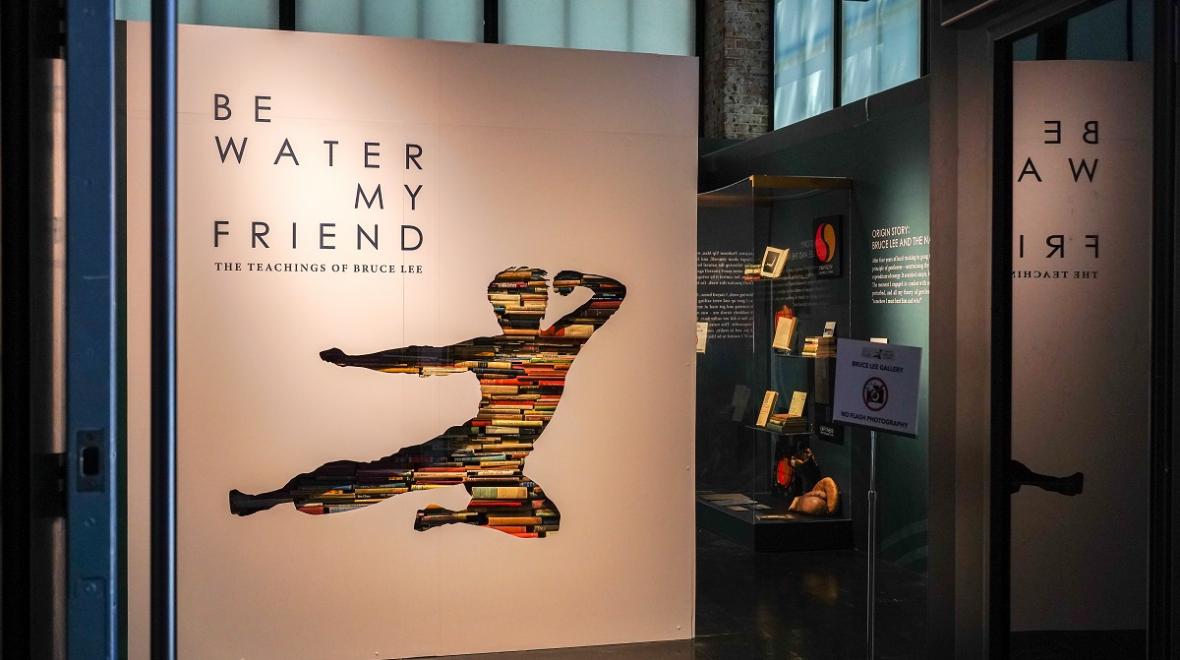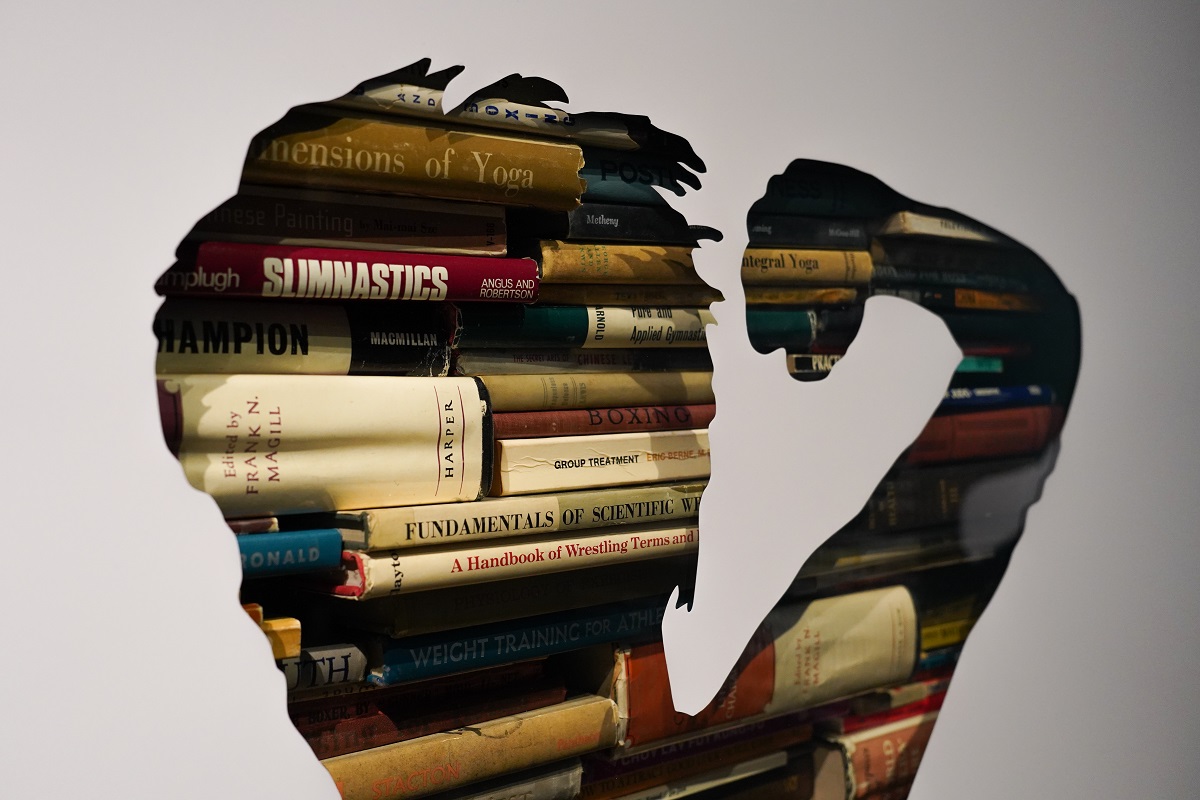
Photo:
Image courtesy of the Wing Luke Museum
The newest exhibit at Seattle’s Wing Luke Museum looks at Bruce Lee from an angle you’d never expect — his books. Wait! Don’t leave yet — even if you’re not the sort of person who makes a beeline for a new friend’s bookshelves to get to know them better, this high-tech, interactive exhibit is a fun way for even little kids to learn about Bruce Lee and what he stood for.
“Be Water, My Friend: The Teachings of Bruce Lee” is the first exhibit in Wing Luke’s new permanent exhibition space dedicated to Bruce Lee. This first exhibit opened last month and will remain on display (with some small tweaks and updates) for about two years before being replaced with new content exploring the legacy of the famous martial artist, actor and philosopher who got his start right here in Seattle. Using Lee’s personal library as a springboard, the exhibit helps viewers understand the man behind the legend.
“Bringing his collection to life shows how his intense pursuit of knowledge came through in his philosophy and his life,” says Exhibit Director Jessica Rubenacker.

Who was Bruce?
Most of us know Bruce Lee as an actor in martial arts movies. Like a lot of parents, I try to resist our culture’s tendency to turn celebrities into role models. I’ve given Bruce Lee a pass because he used his celebrity (you could even argue he became a celebrity) to fight stereotypes and break down barriers for Asian Americans. As this exhibit shows, the Bruce Lee behind the scenes was an even better role model for kids than his on-screen characters.
Bruce Lee was a voracious reader who was interested in a wide variety of topics. He was also a deep thinker who developed a personal philosophy of mind, body and spirit that informed much more than martial technique. Lee concluded that self-understanding and a commitment to one’s authentic self was the cornerstone to making sense of and succeeding in life.

According to Rahul K. Gupta, Wing Luke’s director of education and tours, Bruce Lee’s story is excellent fodder for social-emotional learning. Compared to the narrow brands of modern influencers, Lee’s diverse interests encourage fans to pursue a variety of interesting topics, and his love of reading encourages them to dive deeply into interesting topics instead of “doomscrolling.”
“Kids see it’s great to have different interests that each make the others stronger,” says Gupta.
Lee’s most famous interest — martial arts — makes him a model of self-discipline. Copying his combination of discipline and self-inquiry is a powerful recipe for developing self-esteem. Having faced discrimination himself, Lee was one of the country’s first teachers to open his martial arts schools to everyone. He was an intersectional ally decades before the term emerged.
“He was a real person who faced and overcame real dilemmas and barriers. He’s an example of how you can try and fail and learn from that to try again a different way,” says Gupta. “A lot of his philosophy breaks down into mindfulness practice.”
At Camp Bruce Lee summer camps hosted at Wing Luke, kids learn about the barriers Lee overcame, practice martial and other arts, and use Lee’s famous quote about water to start the flow of their own ideas for philosophical discussions. (Camps fill up fast; sign up to receive Wing Luke’s newsletter to be the first to know when registration opens next year.)
About “Be Water”
If your family attended Wing Luke’s previous Bruce Lee exhibits, you already know about Lee’s accomplishments: developing his own martial arts style and establishing schools in Seattle and Oakland; his scene-stealing role as Kato on the “Green Hornet”; and of course, his roles in classic movies such as “Enter the Dragon.”

Now the partnership between the Wing Luke Museum and the Bruce Lee Foundation that enabled previous exhibits has been made permanent, and the museum has become home to Lee’s personal collection of more than 2,800 books. Rather than simply presenting a static display of books, “Be Water” combines artifacts (including a University of Washington report card that proves great thinkers don’t always get straight A’s!) with introductory text written by his daughter, Shannon Lee. The centerpiece of the exhibit is an interactive digital experience based on Xbox Connect technology that kids will intuitively understand.
River images on the floor of the exhibit are superimposed with quotes from books in Lee’s collection. When you step on these launchpads, you trigger a wall projection that shares a related image, video clip or other content that illustrates how Lee responded to the idea. Since you can never step into the same river twice, each launchpad cycles through 10 different ideas.
How to Be Water
“Be Water” is a small exhibit that won’t strain the attention spans of little kids. But it helps if kids are old enough to read, since even the interactive parts include text. Additional Bruce Lee materials are dotted throughout the museum, making it possible to see all the other exhibits while seeking out Bruce Lee content. A room on the mezzanine level contains information on Lee’s Seattle years. This room also serves as the starting point for Wing Luke’s “Bruce Lee’s Chinatown Tour,” a roughly mile-long outdoor walking tour of neighborhood sites that have a connection to Bruce Lee (recommended for kids ages 6 and older).
Kids won’t want to miss the top floor “Collector’s Corner” display full of collectibles such as posters and toys. Even if your kids have never seen “Enter the Dragon,” after visiting “Be Water,” they’ll be lining up for the photo stand-in. Who wouldn’t want to be like Bruce?
If you go ...Where: The exhibit “Be Water, My Friend: The Teachings of Bruce Lee” is on display at the Wing Luke Museum, located at 719 King St. in Seattle. When: The museum is currently open Wednesday–Sunday, 10 a.m.–5 p.m. Tickets: Adult admission is $17; youth admission for ages 13–18, $15; kids ages 5–12, $10; ages 4 and younger enter free. The Wing does not currently participate in Free First Thursday; Seattle Public Library cardholders can reserve a free museum pass. Parking: The closest pay lots are on Weller between Seventh Avenue and Eighth Avenue; rates range from $5–$20, depending on hours and event days (avoid game days). Street parking is metered and can be hard to find. Consider public transportation; The Wing is served by buses 7, 14 and 36, and is a 5-minute walk from the Chinatown–International District light rail station. COVID-19 precautions: Masks are currently required in the museum; see website for updated safety procedures. |











